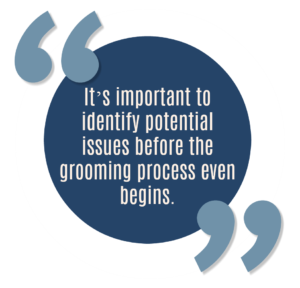 Mats.
Mats.
Tangles.
Knots.
Call them what you like. That woven mess of dirt and hair can often determine what kind of trim can be done on a pet. They are the best friend – and the worst enemy – of the professional pet groomer.
The key to dealing with these trouble areas is knowing how to identify them and deal with them effectively.
4 Types of Mats
- Lack of Maintenance: These mats are the results of dirt, static, and moisture. The owner brushes between grooming appointments but these sessions are not as effective or as frequent as they should be. More frequent bathing and brushing to remove dense undercoat is needed in these cases. The mats produced from poor maintenance are generally smaller and can be removed with the proper knowledge, tools, and products.
- Neglect: These tangles are tough. Typically, these mats are the result of longer-term neglect and are very tight and difficult to remove. The dog’s coat is often in extremely overall poor shape and is very dirty. They can be a hiding place for pests like fleas and ticks and may lead to skin damage or injury.
- Friction: Friction mats are caused when two areas rub together. It could be from a collar, dog sweater, or from a body part (like behind the ears or under the front legs) – but is not limited to those areas. Depending on the activity level of the dog, friction mats could be found up and down the legs, on long ears, or the tail. These are the areas that come in contact with other areas like tall grasses or even the ground.
- Compression: This type of tangle is generally found on the rear of the dog. It is caused from sitting or lying down. Dogs that shed heavily will have dead coat packed into the guard coat, and if not removed, will clump and mat as moisture and compression do their work. Just like people, dogs tend to be left or right-sided. The compression type density will be worse on one side more than the other.
Read the rest of this entry »




